
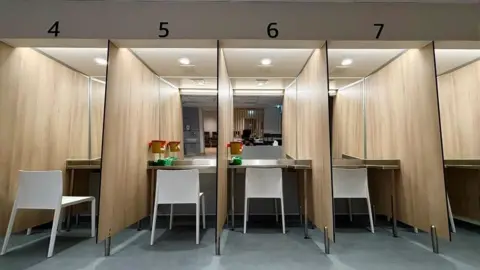 BBC
BBCWelcome to the Thistle – the UK’s first and only drug consumption room.
After nearly a decade of deadlock and wrangling over drug laws the centre is finally ready to open.
On Monday it will welcome its first clients who will come in to inject illegally-bought heroin or cocaine under medical supervision.
The Thistle is based in Glasgow’s east end, where there is a high population of users who take drugs in public.
Funded by the Scottish government, its aim is to reduce overdoses and drug-related harm as well as making drug use less visible to the community.
Users not prosecuted
Drug laws are set at Westminster but are enforced by the Scottish courts.
This scheme can only go ahead because Scotland’s senior prosecutor, the Lord Advocate, announced a change in policy which meant users would not be prosecuted for possessing illegal drugs while at the facility.
The UK government said it had no plans to introduce other consumption rooms but it would not interfere in the Glasgow project.
Some local residents are against the plan, saying they think it will bring more dealing to the area, and an addictions charity claimed it would “encourage people to harm themselves.”
BBC Scotland News was given a tour of the facility.
The Thistle is modelled on more than 100 similar facilities across the world.
It will be open between 09:00 and 21:00 and will operate 365 days a year.
People who arrive at the centre with drugs have to be registered with the service before they are permitted entry.
Inside, there are eight booths where nursing staff will supervise injections and respond to overdoses.
The consumption room will not have the ability to test the drugs being taken, but will provide a safe environment for those using them.
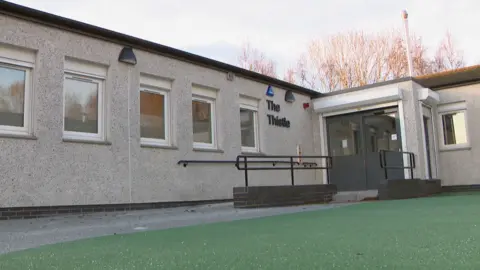
Service manager Lynn Macdonald said staff were still unsure how many injections would take place each day.
“Some services similar in size to this in other countries are seeing up to 200 people a day but it’s really difficult to predict,” she said.
“You will have some people who will maybe come in once a day, you’ll have some people who maybe come in twice a day.
“You’ll maybe have some people who come in 10 times a day depending on their drug use pattern.”
The service also provides medical consultation rooms, a recovery and observation room and a kitchen and lounge area.
Users will also have access to a clothing bank and showers.
The Thistle’s running costs will reach almost £7m over the next three years.
It is situated in the city’s Hunter Street beside a clinic where 23 long-term drug users are currently prescribed pharmaceutical heroin.
The new facility will not provide drugs – users bring their own supply.
A previous report by the NHS estimated there were “approximately 400 to 500 people injecting drugs in public places in Glasgow city centre on a regular basis”.

Dr Saket Priyadarshi – head of alcohol and drug recovery services at NHS Greater Glasgow – is the clinical lead for the service.
“We have a concentration of sites that are long-standing public injection sites,” he said.
“We also know that in the vicinity, there is a concentration of people involved in injecting away from home and who experience some of the highest rates of drug-related harm and fatality in Scotland, if not the United Kingdom.
“It makes sense to deliver at this site, which is where the problem is.”
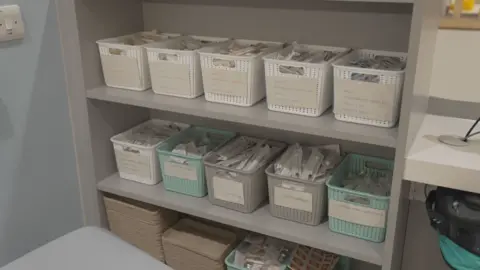
Dr Priyadarshi said he hoped the service would improve issues around drug-related litter and visible public injecting in the local area.
“We are not saying that is going to, in any way, affect the national drug-related death picture, or even the wider city,” he said.
“We are focused on a very concentrated small population.
“Having said that, by setting an example, I do hope that other parts of Scotland will consider whether it is relevant for them.”
Legal barriers
The consumption room is not a new concept.
First trialled in Switzerland in 1986, such facilities have since spread to other European countries including Denmark, Portugal, the Netherlands, Germany and Spain, as well as facilities in Canada and New York City.
Dr Priyadarshi was part of a think tank that first proposed establishing a consumption room in Scotland as early as 2008.
Glasgow’s Joint Integration Board – a body comprising the local NHS and Glasgow City Council that administers health and social care services – first approved plans for the facility in 2016.
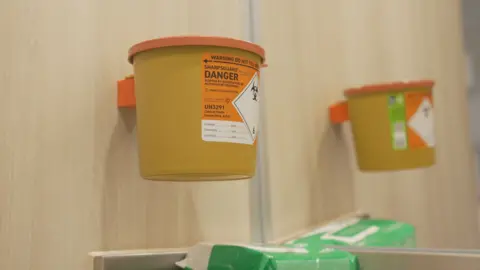
It came after an HIV outbreak among the city’s injecting drug users a year earlier, the worst the UK had seen for three decades.
For the 2016 plan to work, users needed to be allowed to bring class-A drugs – bought from dealers – to an NHS site without being prosecuted.
Despite the proposals being backed by the Scottish government, drug laws are reserved to Westminster.
The Home Office would not back the plan and it was shelved in 2018.
However, it was revived when Scotland’s Lord Advocate Dorothy Bain KC stated that it would “not be in the public interest” to bring proceedings in such cases in 2023.
Community concerns
Health officials were required to consult the local community in the nearby Calton neighbourhood before final sign-off by the Lord Advocate.
Over the course of a year, BBC Scotland News has attended numerous drop-in meetings between the centre’s staff and local residents looking for information about the scheme.
Some remain unconvinced, citing concerns over potential rises in drug dealing and disorder in the neighbourhood.
Others complained about under-investment in one of the poorest areas of the city.
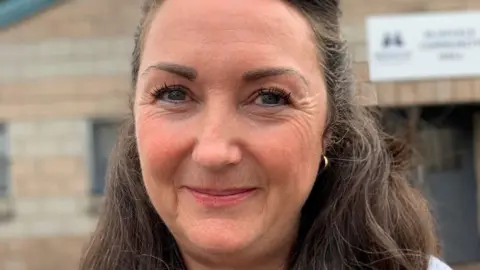
Annemarie Ward is the chief executive of the charity Faces and Voices of Recovery UK, which helped draft the Scottish Conservatives’ Right to Recovery Bill making its way through the Scottish Parliament.
She questioned spending priorities and stated that the facility was a “misnomer of treatment”.
Ms Ward said: “It is a harm reduction intervention, not a treatment.
“It is not in any way innovative or progressive to watch someone harm themselves so drastically and so catastrophically.”
She said it was a “travesty and a devastation” that addicts often don’t have access to recovery services.
Ms Ward added: “Does it stop people from dying? I don’t think it does. I think it encourages people to continue to harm themselves.
“I would like to see the money go into services that can help people get their lives back. “
 PA Media
PA MediaThe Lord Advocate Dorothy Bain KC said: “This policy is an extension of the principles of diversion from prosecution.
“That is a process by which the procurator fiscal can refer a case to a local authority, or other identified agency, as a means of addressing underlying causes of offending.
“In diverting cases we aim to break cycles of harm and reduce the impact of crime on communities.”
She said she was satisfied that the Glasgow facility could provide a way for support services to engage with some of the most vulnerable people in society.
“I understand that this policy may be a source of anxiety for some who live and work near the facility,” she added.
“The policy is very narrow and does not mean other offending will be tolerated.
“Supply offences are not included and Police Scotland will enforce these, and other crimes, as they always have.”
‘Everybody is using’
Julie – not her real name – has been using drugs for six years and was sleeping rough in the city centre when she spoke to BBC Scotland in December.
“The drug situation in Glasgow is a lot harder and more serious now,” she said.
“Everybody is using. You go down a street, you’ll see paraphernalia. You go on a corner, you’ll see someone taking drugs, not caring, bold as brass.
“With this consumption room – I think everyone will use it. But it will be about trust.”
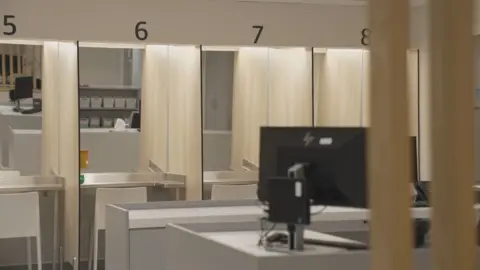
David Clark is also on the streets and is trying to get off drugs after a relapse.
He pointed out the one-mile distance between the city’s shopping district where some users congregate and the consumption room.
“If it is run right, it’s a good thing,” he said.
“But when people buy drugs down here [in the city centre], they won’t want to walk away up there [to Hunter Street], will they?
“That’s the catch.”
He added: “But my thumbs are up for that kind of stuff if it will save lives.”
Drug deaths
Scotland’s drug death crisis is not going away.
The number of fatal overdoses steadily rose throughout the 2010s until a record high of 1,339 in 2020.
Since then, the numbers have stabilised but remained stubbornly high.
While England and Wales saw record overdose deaths in 2023, the death rate in Scotland for the same year was more than double.
In 2021, the Scottish government declared its “national mission” to tackle drug deaths, with £250m funding over five years.
This led to a widespread rollout of the overdose prevention drug naloxone, a focus on improving addiction treatment standards and pledges to increase places in residential rehabilitation facilities.
Scottish Health Secretary Neil Gray has welcomed the centre’s opening.
He said: “It’s absolutely rooted in the centre of the national mission about reducing harm.
“It is about making sure people are able to, in a stigma free way, access services and support. Because it’s not just about the safer consumption element.
“It’s also about the wraparound and holistic interventions that are available as part of that.”
The UK government said it had “no plans to introduce consumption rooms”.
It added: “We will also continue to take preventative public health measures to tackle the biggest killers in our society, including drug misuse, and better support people to live longer, healthier lives.”
A spokesperson said the UK government “will not interfere with the independence of the Lord Advocate with respect to the pilot drug consumption room in Glasgow”.






